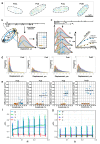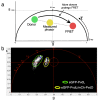PvdL Orchestrates the Assembly of the Nonribosomal Peptide Synthetases Involved in Pyoverdine Biosynthesis in Pseudomonas aeruginosa
- PMID: 38892200
- PMCID: PMC11172790
- DOI: 10.3390/ijms25116013
PvdL Orchestrates the Assembly of the Nonribosomal Peptide Synthetases Involved in Pyoverdine Biosynthesis in Pseudomonas aeruginosa
Abstract
The pyoverdine siderophore is produced by Pseudomonas aeruginosa to access iron. Its synthesis involves the complex coordination of four nonribosomal peptide synthetases (NRPSs), which are responsible for assembling the pyoverdine peptide backbone. The precise cellular organization of these NRPSs and their mechanisms of interaction remain unclear. Here, we used a combination of several single-molecule microscopy techniques to elucidate the spatial arrangement of NRPSs within pyoverdine-producing cells. Our findings reveal that PvdL differs from the three other NRPSs in terms of localization and mobility patterns. PvdL is predominantly located in the inner membrane, while the others also explore the cytoplasmic compartment. Leveraging the power of multicolor single-molecule localization, we further reveal co-localization between PvdL and the other NRPSs, suggesting a pivotal role for PvdL in orchestrating the intricate biosynthetic pathway. Our observations strongly indicates that PvdL serves as a central orchestrator in the assembly of NRPSs involved in pyoverdine biosynthesis, assuming a critical regulatory function.
Keywords: DNA-PAINT; FLIM-FRET; NRPSs; Pseudomonas aeruginosa; co-localization; pyoverdine; sptPALM; super-resolution microscopy.
Conflict of interest statement
The funders had no role in the study design, data collection and interpretation, or the decision to submit the work for publication. The authors declare no other competing financial interests.
Figures





Similar articles
-
Identification of new, conserved, non-ribosomal peptide synthetases from fluorescent pseudomonads involved in the biosynthesis of the siderophore pyoverdine.Mol Microbiol. 2002 Sep;45(6):1673-85. doi: 10.1046/j.1365-2958.2002.03120.x. Mol Microbiol. 2002. PMID: 12354233
-
Subcellular localization of the pyoverdine biogenesis machinery of Pseudomonas aeruginosa: a membrane-associated "siderosome".FEBS Lett. 2013 Nov 1;587(21):3387-91. doi: 10.1016/j.febslet.2013.08.039. Epub 2013 Sep 13. FEBS Lett. 2013. PMID: 24042050
-
Biosynthesis of a clickable pyoverdine via in vivo enzyme engineering of an adenylation domain.Microb Cell Fact. 2024 Jul 24;23(1):207. doi: 10.1186/s12934-024-02472-4. Microb Cell Fact. 2024. PMID: 39044227 Free PMC article.
-
Pyoverdine siderophores: from biogenesis to biosignificance.Trends Microbiol. 2007 Jan;15(1):22-30. doi: 10.1016/j.tim.2006.11.004. Epub 2006 Nov 21. Trends Microbiol. 2007. PMID: 17118662 Review.
-
Nonribosomal peptides for iron acquisition: pyochelin biosynthesis as a case study.Curr Opin Struct Biol. 2018 Dec;53:1-11. doi: 10.1016/j.sbi.2018.01.015. Epub 2018 Feb 20. Curr Opin Struct Biol. 2018. PMID: 29455106 Free PMC article. Review.
Cited by
-
Bacterial siderophores: diversity, uptake pathways and applications.Nat Rev Microbiol. 2025 Jan;23(1):24-40. doi: 10.1038/s41579-024-01090-6. Epub 2024 Sep 5. Nat Rev Microbiol. 2025. PMID: 39251840 Review.
References
MeSH terms
Substances
LinkOut - more resources
Full Text Sources

